 The results of a study were published earlier this month in The Lancet, which found that 11 million deaths in 2017 were attributable to dietary risk factors.
The results of a study were published earlier this month in The Lancet, which found that 11 million deaths in 2017 were attributable to dietary risk factors.
That would mean that poor diets are responsible for more deaths than any other risk factor, including smoking cigarettes!
Among the dietary factors, they also found that low intake of THIS contributes to 3 million deaths…any guesses?
It’s whole grains!
Let’s face it, carbs get a bad wrap. Why?
Largely because, as a society, we consume too many of the wrong types of carbs — refined carbs that are all around us…in white bread, candy, cookies, cereals, drinks and so much more. These carbs create all kinds of health issues and prevent us from enjoying sufficient amounts of foods that nourish and energize us.
Whole grains, on the other hand, should not be lumped in with these refined carbs!
Why whole grains?
 Whole grains are high in nutrients and fiber
Whole grains are high in nutrients and fiber- They help reduce the risk of heart disease, diabetes, cancer and other illnesses.
- In other coaching tips, we have discussed the benefits of the whole grain (the bran, germ and endosperm) remaining intact.
Most of us are familiar with some of the more prevalent whole grains such as whole wheat, oats, brown rice, quinoa, couscous and even farro. These are all excellent choices, and there are several other whole grains (sometimes called “ancient” grains) that provide tremendous flavor and nutritional value. Like quinoa and oats, some of these grains are also gluten free.
More about ancient grains and how to enjoy them…
What the FREEKEH?
 Freekeh (pronounced “free-kah”) is a young green wheat that has been toasted and cracked and some say it is similar to barley.
Freekeh (pronounced “free-kah”) is a young green wheat that has been toasted and cracked and some say it is similar to barley.
Although freekeh is not gluten-free, it does have a really high fiber content, along with other important nutrients.
- Freekeh is loaded with fiber to help fill you up, keep your energy levels high and control blood sugars.
- Like quinoa, freekeh is an excellent source of protein, making it a great option for vegetarians.
- Most freekeh is sold cracked, but it doesn’t matter whether it is cracked or not, it has the same nutritional content.
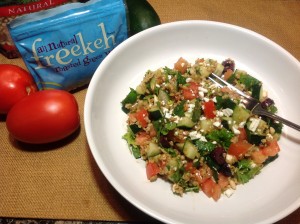 The cooking time for cracked freekeh is shorter (15 to 20 minutes), where non-cracked freekeh takes longer (around 40-45 minutes).
The cooking time for cracked freekeh is shorter (15 to 20 minutes), where non-cracked freekeh takes longer (around 40-45 minutes).
HOW TO COOK IT: freekeh is really easy to cook…simply use a 2:1 ratio of water or broth to freekeh. So, use 2 cups of water or broth for every one cup of freekeh. All you have to do is bring the water and freekeh to a boil, and then simmer covered for 15-20 minutes. The freekeh is done when the liquid is absorbed and the grains are soft.
Freekeh can be used in lots of recipes, such as stir frys, soups, tabbouleh…basically, if you can do it with rice, you can probably do it with freekeh! Try these ideas:
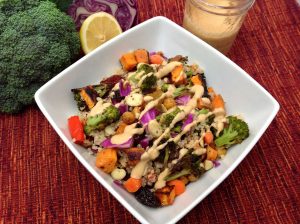 Freekeh Mediterranean Tabbouleh
Freekeh Mediterranean Tabbouleh
Roasted Veggie Bowl with Secret Sauce
BULGUR:
Bulgur is an ancient grain from the Middle East – and it’s perfect for busy people like us!
It’s what is left after the wheat kernels have been steamed, dried and crushed. If you are familiar with the Middle Eastern salad called Tabbouleh, it is often made with bulgur. High in fiber and protein, bulgur is another grain that is great at filling you up without adding significant calories. It also has a low glycemic index, so it is beneficial for those with blood glucose and insulin concerns.
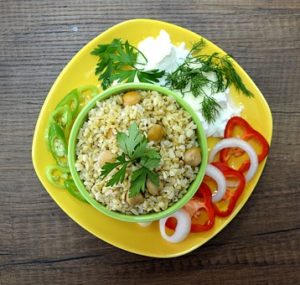 Bulgur is typically found in four grain sizes: fine, medium, coarse and extra coarse.
Bulgur is typically found in four grain sizes: fine, medium, coarse and extra coarse.
- Finely ground bulgur is used in cereals and desserts.
- The medium grains are typically used in stews, salads or vegetarian burgers. Tabbouleh typically uses fine or medium grains.
- Coarse bulgur can be used in salads, casseroles or stuffing.
- Extra coarse can be added to baked goods or used instead of oats or breadcrumbs when making meatloaf or meatballs.
HOW TO COOK IT: the nice thing about bulgur is that it’s already partially cooked, so it requires little time to prepare. If you have ever cooked couscous, bulgur is very similar and the 2:1 ratio works with bulgur too. All you have to do is bring 2 cups of water to a boil, add one cup of bulgur and a dash of salt, remove it from the heat, cover and let it sit for about 20 minutes (the time will vary based on the size of the grain). After that, the water should be absorbed, so just fluff it with a fork and it is ready! If any water does remain, simply drain off the excess liquid.
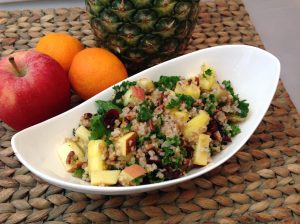 Give these delicious ideas a try:
Give these delicious ideas a try:
Moroccan Salad with Cilantro Orange Dressing
Tabbouleh with Apples and Walnuts
Spinach Walnut Powerhouse Salad
BARLEY:
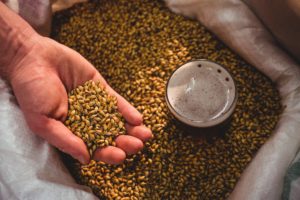 We know you may be thinking – so now where do I find these ancient grains?
We know you may be thinking – so now where do I find these ancient grains?
Many local stores are beginning to carry more and more of these grains, and they can often be found in specialty stores, like Whole Foods or Natural Grocer. There is one grain that is easier to find and can be easily substituted for these…it’s barley – it’s not just for beer anymore!
This ancient grain (the oldest known grain used for food) has a chewy, almost pasta-like consistency and it also packs a punch when it comes to fiber and other nutrients. It has a delicious nutty flavor – the Mushroom and Barley Soup is a great example of this!
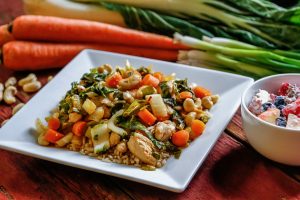 Barley is available in several types including pearl, whole grain, barley flakes and barley grits.
Barley is available in several types including pearl, whole grain, barley flakes and barley grits.
HOW TO COOK IT: these different varieties are pretty versatile, so if you have a recipe that calls for one type (like pearl barley), and you can only find quick-cooking barley, don’t worry, just adjust the time in your recipe and follow the package instructions – it really is that easy!
It can be used in soups, salads, risotto (a favorite!) and can be easily substituted for rice too!
Tomato Soup with Barley and White Beans
MILLET:
You may be thinking, isn’t that a bird seed? Yes, but it’s not just for your parakeet!
You may have seen millet in bird food, and believe it or not, it’s sometimes used in bean bags, but it is also edible and nutritious! Millet is produced in many varieties, primarily in India, Africa and China.
If you have had Indian food, millet may have been part of your Roti (an Indian flatbread). In eastern Africa, millet is used to make beer. In the U.S., its popularity as an ingredient is increasing, especially given its nutrition profile.
 Millet includes magnesium, which helps maintain a healthy blood pressure, helps control diabetes and inflammation, and “keeps you regular” if you know what we mean!
Millet includes magnesium, which helps maintain a healthy blood pressure, helps control diabetes and inflammation, and “keeps you regular” if you know what we mean!- It’s often used in cereals, bread, soup and stews, and it can also be used in a variety of meals as an alternative to quinoa or other grains.
HOW TO COOK IT: some people like the texture of the millet better than quinoa. And, it’s easy to cook! Simply use 2 to 3 cups of liquid, for one cup of millet, depending on your desired consistency. Toasting it before adding the liquid will enhance the nutty flavor of the grains.
Toasted Millet Salad with Picked Onions, Goat Cheese & Greens
Apple Kale Millet with Spicy Shrimp and Bacon
Buckwheat:
Buckwheat — not the one in Alfalfa’s gang — was first cultivated in 4,000 B.C. and is an important part of diets in Asia and Eastern Europe.
If you have ever used Soba noodles, these are made with buckwheat. Buckwheat is gluten-free; however, it is important to know that many soba noodles also use wheat flour as a binder, in which case they are not gluten free…so read those labels!
- Buckwheat is high in important nutrients and minerals that specifically help your bones, skin and help control your blood sugar.
- Buckwheat is commonly found as ground flour in the U.S. for use in foods like breads, muffins or pancakes.
- Similar to other grains, buckwheat can be added to soups and stews or used as an oatmeal. Whole unroasted raw buckwheat kernels are called groats, and can be used in breakfast items and as a thickening agent for soups and sauces. Or, if you find groats pre-toasted they are called “kasha.”
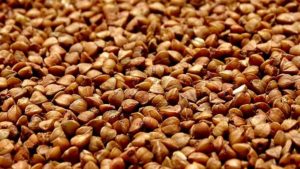 HOW TO COOK IT: if cooking groats or kasha, some say it’s useful to coat them with an egg or oil, and then heat in a skillet until dry…otherwise, they can become a big, thick blob. Then proceed with adding your liquid and cooking them like rice, 2 cups water or broth to one cup of buckwheat groats or kasha, bring to a boil, cover and simmer about 15 minutes until liquid is absorbed.
HOW TO COOK IT: if cooking groats or kasha, some say it’s useful to coat them with an egg or oil, and then heat in a skillet until dry…otherwise, they can become a big, thick blob. Then proceed with adding your liquid and cooking them like rice, 2 cups water or broth to one cup of buckwheat groats or kasha, bring to a boil, cover and simmer about 15 minutes until liquid is absorbed.
Try these buckwheat ideas:
Soba Noodles with Broccoli and Peanut Cilantro Sauce
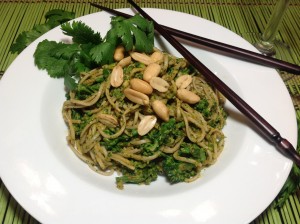 Egg-Topped Soba Noodles with Asparagus and Bacon
Egg-Topped Soba Noodles with Asparagus and Bacon
We encourage you to “get out of the box” and experiment with these whole grains! Your health and heart will thank you!
And, you just might find something new you love — then please share your ideas with us and other Eat REAL America members!
 LEARN MORE ABOUT THE NAPKIN!
LEARN MORE ABOUT THE NAPKIN!
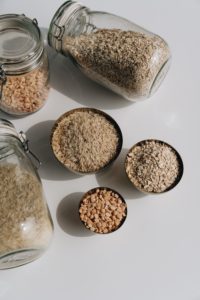
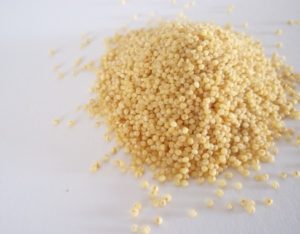
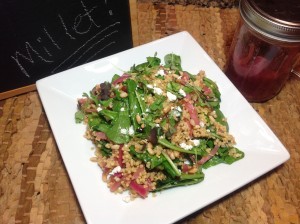

Leave A Comment